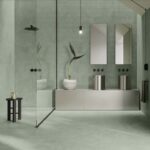Hotel conversion shows lessons in spatial awareness
In 2020, Swedish studio Claesson Koivisto Rune unveiled a boutique hotel conversion in Tokyo, an remains an excellent example on how to re-work spaces to create warm and privacy through the use of different ‘nooks’ and areas.
Previously a bank building that survived the bombing in WW2, the studio aimed to transform the lodging into a warm, cosy place to stay by adding bespoke elements and furniture in deep brown hues.

GALLERY
In each of the 20 rooms (each their own bespoke style), delicate blue ombre curtains surround a wooden desk and cabinet, which guests can use as a private space for personal activities. Similar hand-dyed curtains in blue and white colours also frame the beds.
The design is based around the idea of “aimai”, a Japanese word used to positively describe things that are ambiguous, obscure or vague. It inspired a layout where furniture, textiles and plants are used in place of walls, to create more subtle divisions.
Contemporary details and furnishings help to brighten up the building’s ageing but characterful interiors, while plants are intended to create the feeling of an urban oasis.
“The concrete structure survived world war two fire-bombing raids; its raw interior spaces have a noticeable character and inform the atmosphere of the space,” explained studio co-founder Ola Rune. “This concrete structure has been left exposed in many of the completed spaces, creating a tough, almost brutal, element with which the rest of the interior architecture strongly contrasts.”
The hotel is organised over five levels. The ground floor and basement contain a series of spaces for eating, drinking and socialising, while bedrooms occupy the three upper floors.
The most plant-filled space in the hotel is the Switch Coffee shop, which doubles as a florist. Just beyond is a wine bar and the Caveman restaurant, set against a backdrop of green, blue, pink and clear glass.
Designed in the spirit of a speakeasy, the atmospheric Ao cocktail and tea bar features a small library, while the Brooklyn Brewery is a basement beer hall that fuses Scandinavian, Japanese and German influences.
“Many of the spaces have multiple functions,” said Rune. “These functions do not run in parallel, rather one function hands over its space to the next as the day wains into night time.”
Claesson Koivisto Rune created several furniture designs for these spaces, including a long sofa upholstered in deep red leather, a small wooden stool and a low coffee table.
Bathrooms feature cedar wall panels, black sinks and tiled floors. The same tile, produced by Marrakech Design, can be spotted in different configurations elsewhere in the building, including in the reception and corridors. “We developed a new tile design that was inspired by the existing wood parquet found in some areas of the original building,” explained Rune. “This tile design allowed for a wide range of design possibilities when being laid, meaning that the tile pattern is new is every separate space it is used in.”
Images by Yikin Hyo via Dezeen
Studio Tate has completed a lavish redesign of the 17th floor of a distinctive hexagonal building in Melbourne, ...
Red sculptural interventions define the interior of ARKS’ new flagship store in Bandra West, Mumbai, where Anagram Architects ...
Work is set to begin on a new 12-storey mixed-use affordable housing development in Adelaide’s inner north-west, marking ...
Frame Garden Café, known as Tanatap, represents another prototype in an evolving series of multi-level greenspaces that challenge ...
Italian brand Casalgrande Padana has built a reputation as a prolific producer of ceramic and stoneware tiles, translating ...













